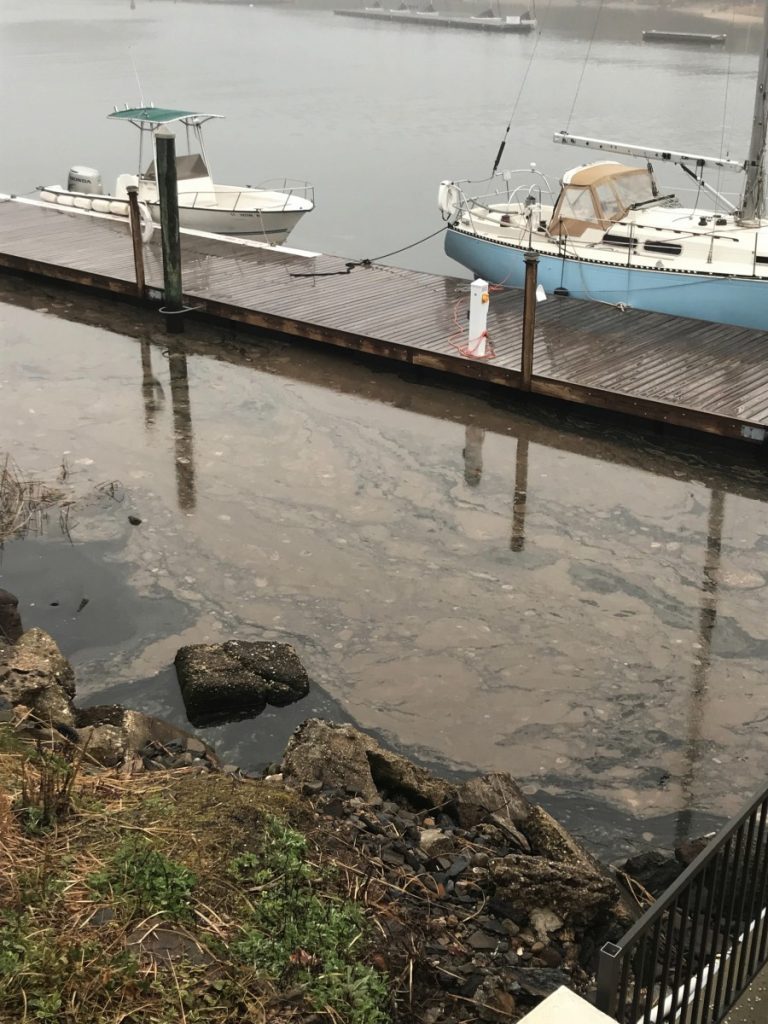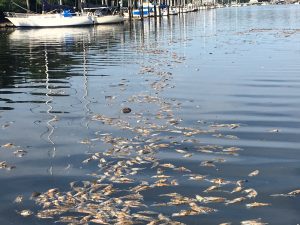Soundkeeper Bill Lucey has been working closely with Bridgeport residents to address their concerns about pollution in Black Rock Harbor. Here’s what he’s learned:

Talk to Kay Williams, founder of Captain’s Cove Seaport at Black Rock Harbor in Bridgeport, CT, and you will soon learn a few history lessons. Black Rock was the port used by George Washington’s spies as they rowed back and forth to Setauket bringing information on British troop movements. This story was popularized by the Netflix series Turn. Black Rock is an ideal harbor, long and narrow protecting much of the channel from the wind and waves of Long Island Sound.
This same geography that makes for ideal boat moorage is also the harbor’s Achilles heel. Water moves in and out with the tide, but overall there is little flushing action which allows nutrients and pollution to build up locally. This is exacerbated by the fact that the Bridgeport Waste Water Treatment Plant West discharges directly into the harbor.
Back to the history lesson. Kay’s father worked on the plant construction in 1948. The original plan called for the sewer outflow pipe to extend through the peninsula out into Long Island Sound proper. Most communities in the area have discharge pipes far from the shore allowing waste to mix in the open Sound. The mayor at the time felt that it was a waste of money to extend the pipe and cancelled that portion of the project ending the pipe at the shoreline half way down the harbor.
Last spring, Kay’s son, Bruce Williams, offered me a free slip at Captain’s Cove Seaport. It is an ideal spot, located at the halfway mark of the Sound’s coastline and a quick trip across to Port Jefferson on Long Island. My slip is 40 feet from the sewage outflow pipe so I have become intimately familiar with Black Rock water quality. The buildup of nitrogen and raw sewage in Black Rock Harbor is reaching a critical point.
The video above was taken underwater in Black Rock Harbor using the expertise of Electrona Robotics.

In response, a group of active residents has formed to clean up the harbor under the umbrella of the Ash Creek Watershed Association. They include local business owners, from a dive operator and marina owner to fuel distributors, local activists, and a City Councilman. The group will sponsor a water quality monitoring effort as part of the Unified Water Study which monitors the health of bays and harbors around Long Island Sound. To date the Unified Water Study, overseen by Save the Sound’s water quality team based in Mamaroneck, NY, includes 36 sites monitored by 20 groups.
The program will collect data on baseline water quality conditions in Black Rock, including water clarity and dissolved oxygen. The Bridgeport Aquaculture School also has students ready join the effort collecting data at 6:00 am when sampling begins.
The Bridgeport City Council has begun to pay greater attention to this problem, and the new data will help us keep up the pressure. This past summer the Council approved the ability to bond at $200 million for upgrading the wastewater plants, sewer collection pipes, and remedies to combined sewer overflows. Save the Sound supports their efforts at garnering state assistance from the CT Clean Water Fund, and will be talking with legislators this winter and spring to ensure the Fund has enough dollars to assist cash-strapped municipalities with critical projects like this one.
As home to the biggest historic shellfish reef in Long Island Sound, it is time to clean up Black Rock Harbor!
